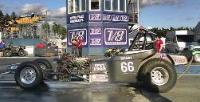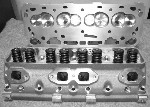|
Author
|
Message
|
|
Don Woodruff
|
|
|
Group: Forum Members
Last Active: 12 Years Ago
Posts: 190,
Visits: 1.6K
|
John: For your amusement I mailed you the EAP files on my proposed build. This is not for max horsepower, but for a strong week end driver. If I get to radical on the Tbird my life will be in peril from the wife. I have turned too many cars into race only, so have to keep this one gentle. This build will have to take a bit of time to complete due to finances. I will dyno it, so we will see how realistically electrons build an engine.
|
|
|
|
|
Don Woodruff
|
|
|
Group: Forum Members
Last Active: 12 Years Ago
Posts: 190,
Visits: 1.6K
|
John: The cam profile used in the engine referenced was one generated for flathead Fords. The reason I have not ordered one of these is I am not sure how good that profile is. It may be very good, but even if I purchased one, and had a cam doctor profile run on it, I am not knowledgeable enough to determine the "goodness" of this profile. I know some excellent local engine builders but these guys rely on the cam companies to design and supply them with compatable parts. I tried Comp Cams but they did not want to go out of their way for a one off oddball engine. The EAP program will evaluate valve train stability if the componet weights and cam profile is entered.
|
|
|
|
|
Hollow Head
|
|
|
Group: Forum Members
Last Active: Last Month
Posts: 1.0K,
Visits: 3.8K
|
Don has a strong point! If we could have a roller cam and lifters for Y, the world would not be the same again...  . Count off friction losses, cam wear etc... Just my opinion, but...
 Seppo from Järvenpää, Finland Seppo from Järvenpää, Finland
www.hollowheads.net (just click the hole in the head to proceed)
|
|
|
|
|
John Mummert
|
|
|
Group: Forum Members
Last Active: 2 Weeks Ago
Posts: 916,
Visits: 7.5K
|
Don, I would be very hesitant to use a cam lobe designed for a flathead engine in a rocker arm engine. While I have never Cam Doctored a flathead lobe I have checked many overhead cam lobes and they would be very ugly in an OHV engine. An OHC valvetrain is just a flathead turned upside down. With no rocker arm, the lobe must be very aggressive to generate even .350" valve lift in a reasonable duration. Without the weight of a rocker or pushrod the designer doesn't need to be very careful about jerk and rapid acceleration changes. Some of worst cam designs I've ever seen were from late model Japanese ATV's. No way you would want to use them in a pushrod engine. With regard to lobe separation, we recommend 108 for engines with headers, 110 for engines with fair headers or very good dual exhaust and 112 for restrictive exhaust. I'm not a hugh fan of wide lobe separation cams such as 112 or more. Generally, low RPM power suffers particularly if the engine also has low compression. Exhaust will also noticeably louder under full throttle.
http://ford-y-block.com 20 miles east of San Diego, 20 miles north of Mexico 
|
|
|
|
|
Don Woodruff
|
|
|
Group: Forum Members
Last Active: 12 Years Ago
Posts: 190,
Visits: 1.6K
|
These are the very things that have kept me form ordering one of these cams. The jerk is a serious consideration but even more is a too agressive lift (forgot the exact terminology) acceleration. I once spent a week trying to decipher a cam design manual that was not written for a beginner. EAP has genaric (mild, and agressive) lift rates as well as well over the nose inputs for the cam profile. I believe, altho I have not tried it, you can put in specified acceleration profiles. I understand where you are coming from on lobe centers but a lot of the old FE HP grinds were on wide lobe centers and the newer designs favor wide centers, probably due to emissions regulations. I have not played much with changing lobe centers, I'll give it a try.
|
|
|
|
|
John Mummert
|
|
|
Group: Forum Members
Last Active: 2 Weeks Ago
Posts: 916,
Visits: 7.5K
|
Don. one other thing too consider is the difference in durations between a hydraulic cam and a mechanical cam. Since the industry standard for hydraulic cam lash is .006" and your typical mechanical cam is .014-.020", cams of equal duration will act quite different. I just checked a 216 @ .050" Crower hydraulic lobe against our Y265S 224 @ .050" mechanical lobe. Both have .280" lobe lift +-.002". When figured with .006" lash for the hydraulic and .018" for mechanical cam the timing at the valve was essentially identical. Due to the difference in lash you must use 8-12 degrees more for a mechanical cam when using your software or seat of the pants speculating what size cam to use. I have sold well over 100 of the Y265S Y-Block cam and no one has ever complained that it was too big, even with a FOM trans.
http://ford-y-block.com 20 miles east of San Diego, 20 miles north of Mexico 
|
|
|
|
|
Don Woodruff
|
|
|
Group: Forum Members
Last Active: 12 Years Ago
Posts: 190,
Visits: 1.6K
|
Ok I mentally missed the delta between the solid and hydraulic cams, the soft ware does not. This explains why software modeling of a 393" Windsor engine using a 214/224 .500 cam was peaking at a higher RPM than the 214/220 .500 in the Y. The extra 4 degrees ex duration did nothing for the Y and very little on the Windsor. My wish list may not be practical, but this is my thing. I tried to push the practical technical limits by asking "can we do this?" during my engineering career, and find it hard to back off now that I have retired.
|
|
|
|
|
speedpro56
|
|
|
Group: Forum Members
Last Active: Last Year
Posts: 1.3K,
Visits: 9.2K
|
John, you're so right by going 8 to 10 degrees bigger when going from hydraulic to a solid lifter cam to get the same results.
-Gary Burnette-
|
|
|
|
|
John Mummert
|
|
|
Group: Forum Members
Last Active: 2 Weeks Ago
Posts: 916,
Visits: 7.5K
|
Don, I was only trying to point out some things you might not have thought of. I'm certainly not trying to tell you that you should not follow your own ideas. Its your engine and your car and so far this is still America and you are free to follow your dreams. A lot of people would argue that building aluminum heads for a Y-Block is not a wise thing to do. I chose not to listen to them.
http://ford-y-block.com 20 miles east of San Diego, 20 miles north of Mexico 
|
|
|
|
|
aussiebill
|
|
|
Group: Forum Members
Last Active: 5 Years Ago
Posts: 1.8K,
Visits: 11.4K
|
John Mummert (5/22/2010)
Don, I was only trying to point out some things you might not have thought of. I'm certainly not trying to tell you that you should not follow your own ideas. Its your engine and your car and so far this is still America and you are free to follow your dreams. A lot of people would argue that building aluminum heads for a Y-Block is not a wise thing to do. I chose not to listen to them. John, you have proven that it was possible to do and have the HP increase to back it up. I hope the orders are coming in, let me know when mine are ready, thanks from everyone here! regards bill.
 AussieBill YYYY Forever Y Block YYYY AussieBill YYYY Forever Y Block YYYY Down Under, Australia
|
|
|
|